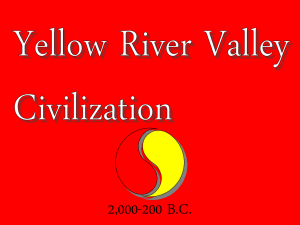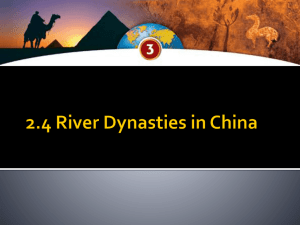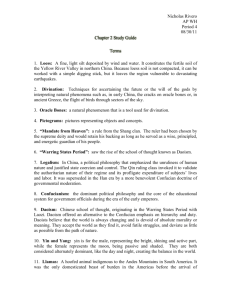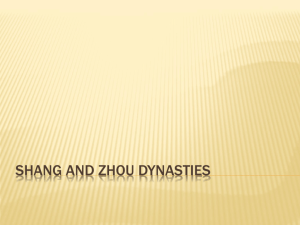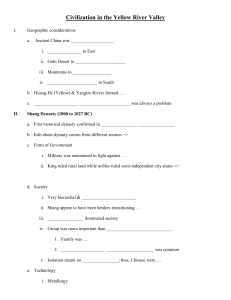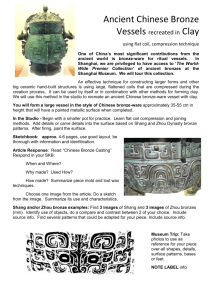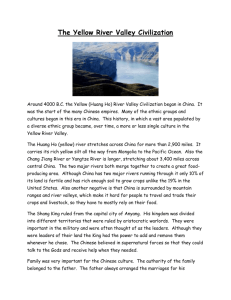Early Chinese Civilizations
advertisement
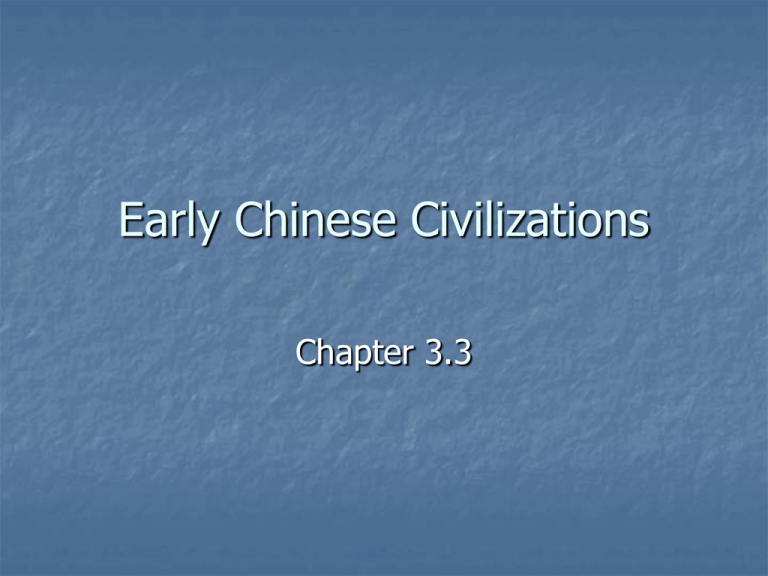
Early Chinese Civilizations Chapter 3.3 Facts China has one of the world’s oldest cultures. It has the largest population (1.3 billion) of any nation. It is made up of more than 50 ethnic groups, speaking several languages and many dialects. Geography 1. 2. Rivers The Huang He (HWAHNG HUH), or Yellow River stretches across China for more than 2,900 miles. The Chang Jiang (CHAHNG JYAHNG), or Yangtze River stretches for 3,400 miles. Both empty into the Pacific Ocean and Yellow Sea. Geography Only 10 percent of the total land area is suitable for farming, compared with 19 percent of the U.S. Mountains & Deserts These border the northern and western frontiers. Himalayas and Plateau of Tibet have high elevations. Climate Winter is very long cold and dry due to the monsoons blowing from the mountains. Summer is short, sunny and hot. The Chang Jiang serves as the dividing line between the northern region and the southern region of the country. The Shang Dynasty The beginning of Chinese civilization was the founding of the Xia (SHYAH) dynasty over four thousand years ago. Supposedly founded by Yu the Great Based on legend and archaeology; Yu may not have existed. (1750 B.C. to 1045 B.C.) The Shang Dynasty replaces it. This was a farming society ruled by an aristocracy 1. 2. Wealth was based on land Power is passed from one generation to another Shang Political and Social Structures China built its first cities. The king ruled from the capital and divided territories governed by aristocratic military leaders, called warlords. Like in Egypt, Chinese kings were buried in tombs. Hierarchy of social structure Royal family at top Aristocracy Merchants & artisans Peasants made up the majority Slaves at bottom Shang Religion and Culture Priests used oracle bones to communicate with the gods by scratching questions on them. Heated metal rods were then stuck in to the bones and caused them to crack. Priests interpreted cracks as answers. They believed in life after death. Some Chinese continue to burn replicas of physical objects to accompany them to the next world. “Ancestor Worship” is where Chinese treated their ancestors well so as to bring good fortune (rather than bad) to their families. The Zhou Dynasty The last Shang ruler swam in the “ponds of wine” and ordered the writing of music that “ruined the morale of the nation.” This led the ruler of the state of Zhou (JOH) to revolt and establish a new dynasty. The Zhou dynasty was the longest lasting dynasty in Chinese history and ruled for almost 800 years (1045 B.C. to 256 B.C.) Zhou Political Structure Zhou kings ruled in much the same way as the Shang. One difference was the Mandate of Heaven principle. This was the belief that the king was the link between Heaven and earth. The king ruled by a mandate, or authority to command, from Heaven. However, the king was then responsible for ruling the proper “Way”, called the Dao (DOW). If the king doesn’t rule effectively, he could be overthrown and replaced by a new ruler. The Fall of the Zhou Dynasty The Zhou kingdom had been divided into several smaller states that challenged the ruler. (403 B.C.) Civil War broke out, beginning an age known as the Period of the Warring States. (221 B.C.) One of the warring states—the Qin (CHIHN)—took control. Warfare Change Iron weapons rather than bronze weapons came into use. Foot soldiers, or infantry, and soldiers on horseback, cavalry, made their appearance. Cavalry had the crossbow, which was invented by the Chinese in the seventh century B.C. Social Structure of the Zhou Peasant families farmed an outer plot for its own use. Trade included goods brought in from distant regions. Joined with other families to work the inner plot for their landlord. Salt, iron , cloth The family was the most important social institution. The need to work together on the land. Social Structure of the Zhou Rice requires hard work to plant, grow, and harvest. Irrigation network Children worked in the fields Later, sons were expected to take over the physical labor on the family plots and provide for their parents. Filial Piety At the heart of the family concept. Filial refers to a son or daughter. Filial Piety refers to the duty of members of the family to subordinate their needs and desires to those of the male head of the family. Every member has his/her place. Male supremacy was a key element. Men worked the fields and were the warriors, scholars, and government ministers. Filial Piety Women raised the children and worked in the home. Some women influenced politics if they were part of the royal family. Poem “A clever man builds a city, A clever woman lays one low; With all her qualifications, that clever woman is but an ill-omened bird.” Quotes “Well behaved women rarely make history.” Laurel Thatcher Ulrich “To be happy with a woman you must love her a lot and not try to understand her at all.” Helen Rowland Zhou Accomplishments Because of the advances in farming tools and practices, China’s population rose as high as fifty million people during the late Zhou period. Iron was used to plow land. Growth of trade had a lot to do with silk. The Silk Road—trade network to Europe and India Fragments have been found in Athens, Greece. Chinese written language was simple script back then, but complex today. Pictographs are picture symbols, or characters, which represent an object. Zhou Accomplishments Ideographs are characters that combine two or more pictographs to represent an idea. Word east symbolizes the sun coming up behind the trees. There was a sound associated with each character when a person read it aloud. Other cultures quit using pictographs and ideographs in favor of phonetic symbols, such as the Roman alphabet. Chinese began attaching phonetic meaning to some of their symbols but have never entirely abandoned its original format. Chinese Philosophy Chinese philosophers were concerned about the material world and creating a stable society. Three major schools of thought about human beings and the universe emerged: Confucianism, Daoism, Legalism Confucianism Confucius is the westernized form of Kongfuzi (KUNG FOO DZUH), meaning master Kung. Born in 551 B.C. He traveled around China in an attempt to persuade political leaders to follow his ideas. Few listened, but some faithful followers recorded his sayings in the Analects, and spread his message. Through 1800s, almost every Chinese pupil studied his ideas. His philosophy was political and ethical, not spiritual. If humans would act in harmony with the universe, their own affairs would prosper Encouraged duty and humanity Daoism Based on the teaching of Laozi (LOW DZUH). He lived during same period as Confucius. Scholars don’t know if he really existed. Daoism sets forth proper forms of human behavior. Daoism vs Confucianism Followers of Confucius believe that it is the duty of human beings to work hard to improve life here on Earth. Daoists believe that the way to follow the will of Heaven is not through action but inaction: “Without going outside, you may know the whole world. Without looking through the window, you may see the ways of heaven. The farther you go, the less you know. Thus the sage (wise man) knows without traveling; He sees without looking; He works without doing.” Daoism The best way to act in harmony with the universal order is not to interfere with the natural order. The universe is sacred. You cannot improve it. If you try to change it, you will ruin it. If you try to hold it, you will lose it.” Lao Tsu Legalism Legalism proposed that human beings were evil by nature. Legalists were referred to as the “School of Law” because they rejected the Confucian view that government by “superior men” could solve society’s problems. They believed in a strong ruler and that only harsh laws and stiff punishments would cause common people to serve the interests of the ruler. To them, people were not capable of being good and the ruler did not have to show compassion for the people.

